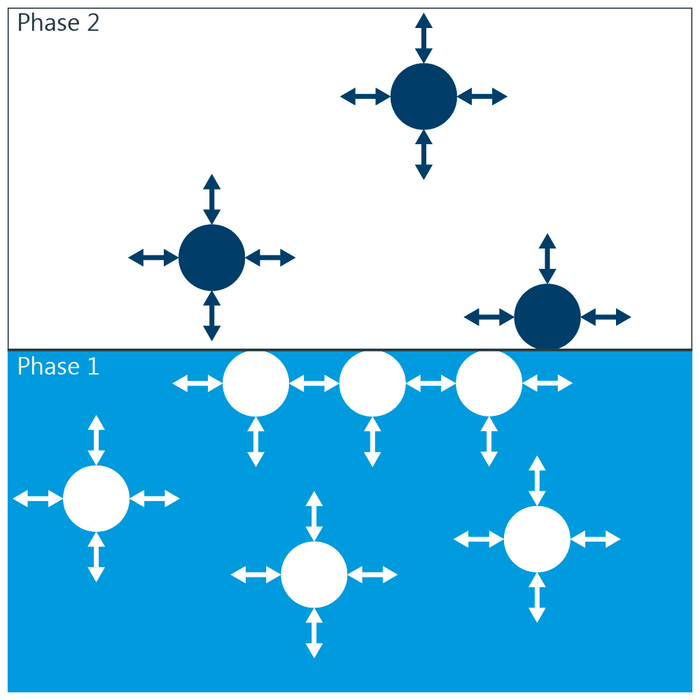Interfacial tension
In the broader sense, interfacial tension is defined as the work which must be expended to increase the size of the interface between two adjacent phases which do not mix completely with one another. In the narrower sense (and in this glossary) the term relates to the liquid/liquid and liquid/solid phase boundaries, while for the liquid/gaseous interface we refer to surface tension and for the solid/gaseous interface we refer to surface free energy.
Background
As a measure of work per unit area or force per wetted length, interfacial tension has the units mN/m and is designated by the symbol σ or γ (lower case sigma or gamma).
At a phase boundary, the sum of the interactions with the molecules of the same phase is greater than that of the interactions with molecules of the other phase. Accordingly, molecules at the interface have fewer attractive interacting partners than in the volume phase. The phases therefore form the smallest possible interface without the action of external force. Work must be done in order to increase the size of the interface.

As with surface tension, differentiation is made between the static interfacial tension (measured in equilibrium with mechanically unchanged interface) and the dynamic interfacial tension (measured while the interface is changing).
Significance
The interfacial tension plays an important role in many processes and phenomena where different phases touch one another:
- Emulsions and emulsifiability: The interfacial tension affects the emulsifiability and the tendency for the phases to separate.
- Flooding (for example with tertiary crude oil production): If the interfacial tension is reduced by means of surfactants, the organic phase can be mobilized after flooding with water.
- Quality tests of hydrophobic liquids: The ageing of a hydrophobic liquid often goes hand in hand with a reduction in the interfacial tension with water. In such cases, measurement of the interfacial tension is an important quality test, for example with transformer oil.
- In the case of solid-liquid phase boundaries, the interfacial tension affects the long-term stability of the interface contact, for example with gluing and coating processes.
Measuring methods
Liquid-liquid interface:
- Ring method according to Du Noüy: The force acting on an optimally wettable ring as a result of the tension of the withdrawn liquid lamella when moving the ring from one phase to another is measured in this method.
- Plate method according to Wilhelmy: The force acting on an optimally wettable plate which is immersed vertically in the lower phase is measured in this method.
- Rod method: As the plate method, wherein a cylindrical rod with a smaller wetted length is used for measurement with a smaller liquid volume.
- Drop volume method: The volume of a drop of liquid produced at a vertical capillary in another liquid is measured at the moment of its detachment.
- Spinning drop method: A horizontal capillary filled with a bulk phase and a drop phase is set in rotation. The diameter of the drop which is elongated by centrifugal force correlates with the interfacial tension.
- Pendant drop method: The shape of a drop on a needle in a bulk liquid phase is determined, among other things, by the interfacial tension. The interfacial tension can be ascertained from the image of the drop using drop shape analysis.
Liquid-solid interface:
- Measurement of the contact angle: As well as its surface free energy, the interfacial tension of a solid with particular liquids can also be calculated from the contact angle of the various liquids with the solid.





